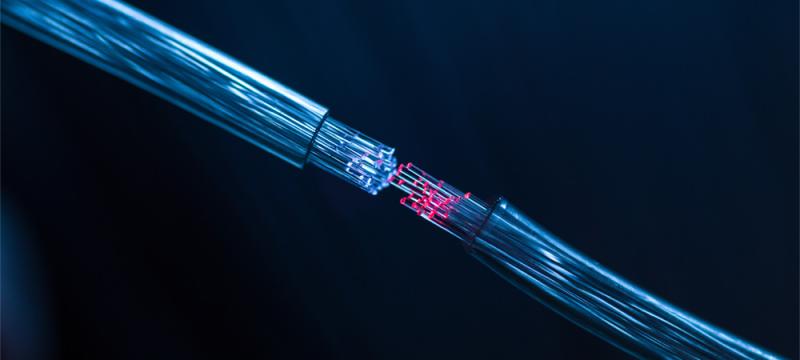Distributed fiber optic sensing (DFOS) technology allows for real-time monitoring along hundreds of kilometers of fiber optic cable. Through the use of optical time-domain reflectometry and Rayleigh backscattering, DFOS can measure acoustic, temperature, strain, and vibration signals along the entire length of a fiber. This enables continuous monitoring across large areas and linear assets like pipelines, railways, power cables and perimeter security.
How DFOS Works
In Distributed Fiber Optic Sensor, laser pulses are sent down the fiber and Rayleigh backscatter is analyzed. This backscatter occurs naturally as light travels through the silica fiber and scatters off irregularities in the fiber's structure. By measuring the time it takes backscattered light to return, it is possible to precisely locate events along the fiber. When external stimuli like acoustic waves or temperature changes occur close to the fiber, they cause slight changes in the backscatter that are detected and localized. Modern interrogation units can monitor tens of thousands of points along kilometers of fiber with resolutions down to 1m.
Applications for Critical Infrastructure Protection
Pipeline Monitoring
DFOS technology allows pipeline operators to remotely monitor the entire length of their assets in real-time. Distributed temperature and strain sensors can detect third-party strikes, leaks and operational issues before financial or environmental damages occur. They also help optimize pipeline inspection processes. During large emergency events, DFOS provides situational awareness along the entire critical infrastructure.
Rail Monitoring
On rail lines, distributed acoustic sensors using DFOS principle can monitor for intrusions or issues along the track from a singlesecure location. They detect traffic, storms, landslides and other acoustic events to maintain safety and predict maintenance needs. Thermal effects from draindrainage problems beneath the track can also be identified. This provides a cost-effective alternative or supplement to wayside equipment and helps secure rail infrastructure.
Perimeter and Structure Monitoring
For sites with long perimeter fences or areas to protect, DFOS fiber can be embedded or attached in a waythat detects any disturbances or intrusions. Above-ground assets like dams, bridges and buildings can also be monitoredcontinuously for vibrations or strain changes that may indicate structural issues. This enhances security for criticalsites in a non-intrusive manner.
Advantages over Traditional Monitoring Systems
Continuous and Distributed
Unlike spot sensors, DFOS provides continuousinsight along the entire length being monitored. It detectsissues instantly wherever and whenever they emerge ratherthan rely on spaced sensors or intermittent scans. Thisdelivers improved situational awareness for real-time response.
Cost-Effective for Large Areas
Traditional sensor networks require numerous discretesensors which are costly to purchase and maintain at scale.DFOS installations have much lower sensor deployment andpower costs since a single fiber acts as a distributed sensor.This makes it practical for large-scale infrastructuremonitoring.
Future-Proof and Flexible
Once optical fiber is deployed, additional capabilitiescan be enabled remotely through software. The same fiberinfrastructure can support new applications throughfirmwareupgrades without needing new cabling or sensors. Andif reconstruction or expansion occurs, the fiber sensornetwork easily scales alongside.
Low Maintenance
Fiber optic cables require no electrical power along their length or risk of electromagnetic interference likewirelessoptions. As a passive system, DFOS has very low lifecycle costs once installedwith minimal active componentsthat require maintenance over decades ofuse.
The Future of Distributed Fiber Optic Sensor
As DFOS technology continues advancing,the ability to continuously monitor vast linear assets andareasin real-time will grow. Higher spatial resolutioncombined withintegrations to AI/ML analytics platforms will unlock newpredictive use cases.More complicated multiplexed sensor designs will allow sensingdifferent parameters simultaneously onthe same fiber infrastructure for an even more completeoperating picture.
In Summary, with its cost benefits, future-proof scalability andcontinuousawareness - DFOS looks positioned to becomea fundamental enabling technology for global criticalinfrastructure security and optimization in coming years.Its realization of truly distributed intelligencealong extendedassets will revolutionize how societies monitor and protectessential services and facilities from both external threatsand internal operational issues.
Get More Insights on- Distributed Fiber Optic Sensor
Explore Related Article- Cloud Native Software Market
About Author:
Ravina Pandya, Content Writer, has a strong foothold in the market research industry. She specializes in writing well-researched articles from different industries, including food and beverages, information and technology, healthcare, chemical and materials, etc. (https://www.linkedin.com/in/ravina-pandya-1a3984191)
